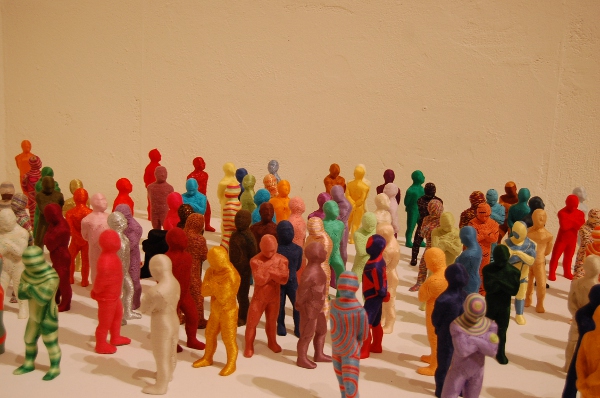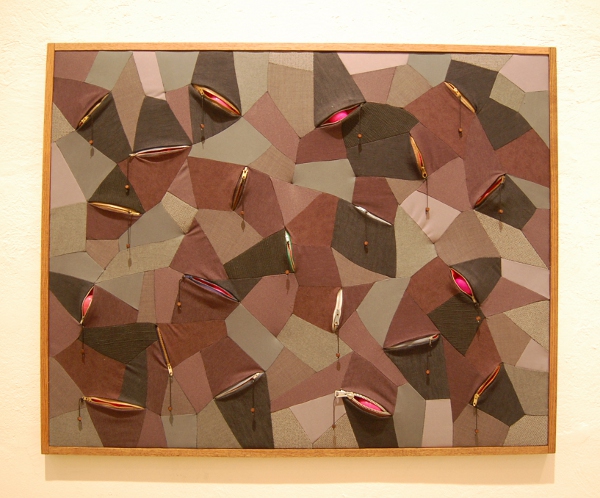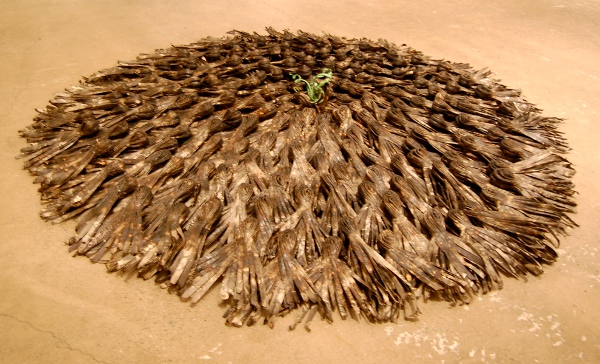
Thinking “Outside/Inside the Box” with a FiberPhiladelphia gem
If the FiberPhiladelphia 2012 festival had a crown jewel it would almost certainly be “Outside/Inside the Box.” This massive exhibit at “The Icebox” room of the Crane Arts Building in Fishtown showcases fiber work in many mediums, including fabric, glass, leaves and newspaper, to name only a few. There are nearly 70 artists demonstrating their skills in the show, which makes for a potentially lengthy stay — but with so much quality content to take in, it’s well worth the time. The show was juried by Elisabeth R. Agro, Bruce D. Hoffman and Judith Weisman.
Attempting to cull standout pieces from the wide array of selections is difficult, to say the least. This diverse exhibit is definitely a something-for-everyone type of event. There were a number of awards, however, including The Patricia Malarcher Award for Best in Show which went to Ann Wessmann for her installation “Words Unspoken Series: 37,499 days — June 9, 1932 – December 31, 1941.”
Second Place was snagged by June Lee for her series “Bystander.” Lee utilizes fabric and mixed media to wrap tiny, colorful figures in different poses. Many of the little people appear to be deep in thought or contemplation, almost as if they were examining an artwork themselves. The feedback loop of the viewer observing characters which appear to be critiquing art is entertaining, but the most striking thing about them is their demeanor. All of their body language is extremely precise and palpable. Some of the inactive bystanders are crouching, although most are standing. Many have their arms crossed, but a few have their hands locked behind their backs. Their apparent humanness is what makes these tiny figurines powerful.
Susan Iverson’s work entitled “Winter Walk” is fairly minimal but entirely spiritual. Two long swaths of wool hang draped from the wall in deep, arched forms. At the bottoms of the fabric — and the apex of the parabolic curves — rest two egg-shaped hunks of frosted glass. The black- and gray-woolen components are reminiscent of stoles or other priestly vestments. Hanging below, the glass is more like a gemstone or ice crystal, which hints at the origin of the name. Whether seen as a thoughtful stroll through the snow or some type of strange ritual, Iverson’s work is quite profound.
The patchwork of Bryan Day is quite amusing and also strangely organic. “Zipperwall Quilt 2” is a rectangular frame full of faceted bits of salvaged cloth. In many of these sections there are open zippers which are both vaginal and mouth-like. Bright, plastic Easter eggs poke through the metal teeth of the zippers, implying movement or emergence. The synthetic feel of the fabric and metal is countered by this piece’s appearance as a living organism.
Jan Hopkins has a roughly 3-foot tall sculpture entitled “Lady Bug,” which was crafted from a number of organic sources: philodendron and eucalyptus leaves, grapefruit peels, cedar bark and ostrich shell beads among them. The headless, handless body stands straight and on its back is the carapace of a ladybug. It is beautifully ornate and bridges the gap between human and nature in both materials and concept.
Repurposed newspapers make up the mandala called “Hope” by Riccardo Berlingeri. Why the word hope? Perhaps the recycled materials speak to environmental hope and aspirations of fixing our systems which produce unnecessary waste. The fact that opening a newspaper usually presents us with a barrage of bad news is another idea. By altering the news publications and their often challenging content almost beyond recognition, this work imagines a circular unity outside the realms of political and media firestorms. A small green sprout rising from the center couldn’t be a bad interpretation of the name either.
Needless to say, “Outside/Inside the Box” absolutely warrants a visit. The brief summaries provided here do such a vast exhibition no justice. In the adjoining room there is an additional sister show of “Distinguished Educators,” which provides a slightly different take on the FiberPhiladelphia from the perspective of teachers, five of whom taught (or teach) in Philadelphia. Both shows run until mid-April with an upcoming reception on March 31 from 5 to 8 p.m.
The Crane Arts Building is located at 1400 N. American St.; 215-232-3203.
Recent Content
-
Artsarticle ·
-
Artsarticle ·
-
Artsarticle ·




